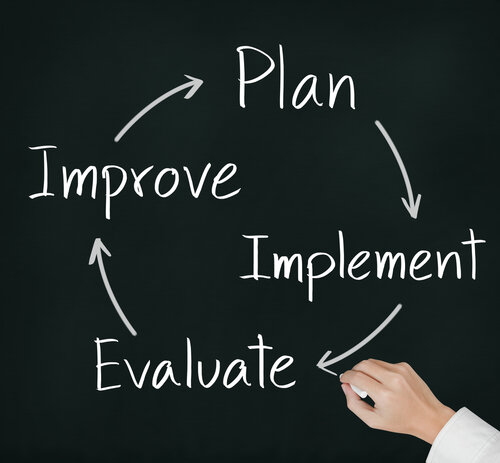What is an Evaluation Culture and Why Do You Need One?
Image description: The word “Evaluation” is written in black marker with a red underline. Around the word are five hands, two pointing at the word and one holding a marker, two cups of coffee, and a pair of glasses
Over the last decade plus working in evaluation, I’ve found myself coming back to a routine conversation: defining evaluation and the value it can have. Evaluation is well-known but unfortunately misunderstood by many in the nonprofit space, from those working in nonprofits to those consulting and funding them. It is often seen as an accountability measure, a requirement presented by a funding authority, an administrative burden, or even an audit. It’s distilled down to easy to gather metrics like participant counts and quick surveys. While these quantifiable metrics are valuable and important pieces of the evaluation process, they are not the heart of what evaluation is and the true value of how it can help guide and inform our work.
Evaluation at its core is based in learning.
Often, when I first start working with a new organization I’m asked, “what do we have to do?” or “what do they want?” (they typically referring to a funder or administrative authority). In my humble but professionally-grounded opinion, the best way to answer these questions is in fact to forget about them- or more realistically, set them aside for later. The best use of evaluation is to investigate the questions you have for your organization. What do you want to learn? What will help you do your work better? What do you already know and what questions do you have that you’re not sure how to answer? Evaluation can be a powerful and valuable tool to help organizations and programs dive into these questions and ultimately strengthen their work to have the greatest impact. Once you start to answer these questions, build data gathering into your work and processes, and learn ways to translate what you learn, it gets easier to frame the information you have in a way that answers any questions that come to you, whether they are from funders, your board, or members of your community. As an added bonus, these groups are often happy to see the organization’s commitment to an investigative data-driven process and dedication to using evaluation as a way to figure out how to do their best work.
Image description: The words “Plan,” “Implement,” “Evaluate,” and “Improve” are written in a circle with arrows between them, indicating a cycle. A hand holds a piece of chalk as though there is someone writing the words on a chalkboard.
While in-depth, robust evaluation projects are a great tool to learn about your work, they can remove the evaluation process from a holistic learning process. In addition to many times being inaccessible and impractical, they isolate evaluation into a specific project or task that loses the opportunity for holistic learning that can be truly transformative. Integrating evaluation in a more holistic process is what I refer to as evaluation culture. Building an evaluation culture in your organization helps to remove the structural burdens often associated with evaluation. It allows an organization or program to build in evaluation activities that are easy, affordable, and integrated into their work, and that ultimately make it easier.
What does that look like?
Rather than trying to figure out what outside stakeholders want to know, you will gather information that helps you do your work better.
Instead of scrambling to put together information at the end of a grant cycle, an evaluation culture will allow your staff to have information available and accessible at any point it is needed.
Building in evaluation processes allows for more perspectives and input from your staff and community.
A streamlined information flow allows you to respond to the varying needs of your participants and community.
You can be confident that updates, pivots, and program changes are based in data.
Image description: A grey and white drawing of a hand holding a megaphone with the words “Your Voice” on the left.
It might seem like a big mistake to move the focus away from oversight authorities like funders, but when you have a strong evaluation culture, sharing what you’ve learned becomes a task for framing and communications- what you learn will guide how you share information instead of letting your learning be driven by outside influences. What’s even better, you will be supported by confidence in the value of the information you’ve collected and what you’ve learned. Backing up information you know well and believe in is always easier than trying to craft a response to meet someone else’s demands.
Wondering where to start? Here are a few of my biggest tips:
Focus on your mission, goals, and big questions. Ask: What do we want to learn? What information will help us do our work better? What does success look like?
Be creative in what you consider “data” or valuable information. What information do you already have that answers your big questions? Where are there opportunities to get new information?
Integrate information-gathering into your everyday work. Is there an easy way for program participants to provide feedback? What about staff? How are you collecting this information?
Use this information to guide your work. Who has access to the “data?” Do you talk about it during staff meetings or with the board? What do you do when you learn something new? How do you decide what changes to make in your programs?
Share what you’ve learned. Frame your information into a format for a grant report or share it with your community.
When you start to see evaluation as a process that can support your work, it can be truly transformative in helping you do your work and have the impact you want. Ultimately it will make your work (and reporting) easier and more impactful, and you will have the confidence to know what is going on in your programs and how to respond to community needs or changes in the environment.
Want to learn more?
Download the Evaluation Culture Workshop Series
Check out our free evaluation resources
Contact us for a free consultation




